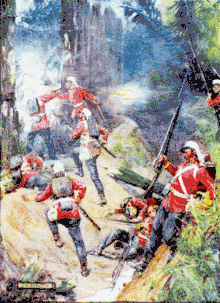William Hulme (British Army officer)
Lieutenant Colonel William Hulme (1788 – 21 August 1855)[1] was an officer in the British Army, and commanded the 96th Regiment of Foot, raised at Manchester.
Flagstaff War
His military career was most notable for his involvement in the "Flagstaff War", also known as the First Anglo-Māori War, which took place in New Zealand between 1845 and 1846. Lt Col Hulme was in command of the colonial forces at the attack on Heke's Pā at Puketutu on the shores of Lake Omapere (sometimes called Te Mawhe Pā).[2] In May 1845 Heke's Pā was attacked by troops from the 58th, 96th and 99th Regiments with marines and a Congreve rocket unit.[3]

The colonial forces arrived at Heke's Pā at Puketutu on 7 May 1845. Lieutenant Colonel Hulme and his second in command Major Cyprian Bridge made an inspection of Heke's Pā and found it to be quite formidable.[4] Lacking any better plan they decided on a frontal assault the following day. Te Ruki Kawiti and his warriors attacked the colonial forces as they approached the pā, with Heke and his warriors firing from behind the defences of the pā. There followed a savage and confused battle. Eventually the discipline and cohesiveness of the British troops began to prevail and the Māori were driven back inside the pā. But they were by no means beaten, far from it, as without artillery the British had no way to overcome the defences of the pā. Hulme decided to disengage and retreat back to the Bay of Islands.[5] Lieutenant Colonel Hulme returned to Auckland and was replaced by Lieutenant Colonel Despard, a soldier who did very little to inspire any confidence in his troops.[3]
Later life
In 1846 he purchased a house in Parnell, Auckland, which became and is still known as Hulme Court. While not open to the public, this is on the New Zealand Historic Places register and is one of the oldest documented houses in Auckland still standing.[6]
William Hulme was later appointed by Governor Grey as the first Postmaster-General of New Zealand's national Post Office. He died on 21 August 1855 in his 68th year. He was buried in Symonds Street Cemetery.
References
- McKenzie, Joan (11 April 2011). "Burrows House, Parnell" (PDF). New Zealand Historic Places Trust. p. 3. Retrieved 28 September 2011.
- "Puketutu and Te Ahuahu - Northern War". Ministry for Culture and Heritage - NZ History online. 3 April 2009. Retrieved 17 September 2011.
- Raugh, Harold E. (2004). The Victorians at war, 1815-1914: an encyclopedia of British military history. ABC-CLIO. pp. 225–226. ISBN 9781576079256.
- Reeves, William Pember (1895). "F. E. Maning "Heke's War … told by an Old Chief"". The New Zealand Reader. Samuel Costall, Wellington. pp. 173–179.
- Cowan, James (1922). "Chapter 6: The Fighting at Omapere". The New Zealand Wars: a history of the Maori campaigns and the pioneering period, Volume I: 1845–1864. Wellington: R.E. Owen.
- "Hulme Court". Register of Historic Places. Heritage New Zealand. Retrieved 21 December 2009.
